OFF-TOPIC (8)
By:
August 6, 2019
Off-Topic brings you over-the-transom, on-tangent essays, dialogues and subjective scholarship on an occasional, impulsive basis. This time, a brief spell in possibility with two of the local architects of existence…
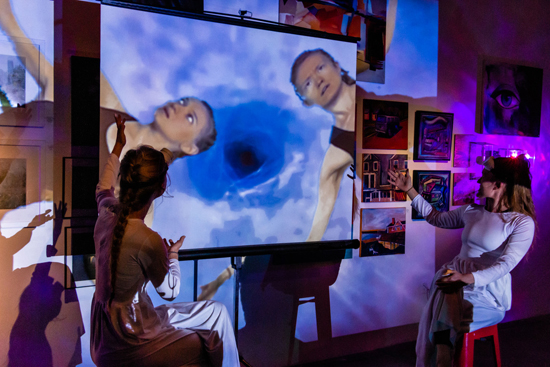
We may all be headed for a cosmic drain, but it’s the circling that matters. With the Dirt [contained] Theatre Company’s Crushing Baby Animals, I feel I may have seen my first true gesamtkunstwerk — and nobody even sneezed. Only the performers were hurt during the making of this production, and that was years ago anyway. Staged in the semi-labyrinth of Long Island City Artists’ Plaxall Gallery, we follow like a group tour of the abyss as “Tana” and “Maria” (played by the play’s creators, Tana Sirois and Maria Swisher) struggle to conceive a career-defining Dante’s Inferno but end up spiraling down the rabbit-holes of their own psyches.
Actually it’s a high hell; the close creative partners come to realize they’ve each had the identical recurring dream since childhood, in which they are straining to save a multitude of innocent creatures from a tornado but only end up dropping and crushing them. It’s a nightmare we’re only surprised more people don’t have in the era of climate anxiety and kids in cages, but in the world of the performance, this crossing of threads in the collective unconscious causes a wormhole to open which sends Tana and Maria on a quantum quest through possible universes and their own unreliable pasts. Many worlds and pearls of wisdom build around the grain of sand that was their original intention, as Dante, Beatrice and Virgil disappear deeper into the shadows and the crumpled drafts of Tana and Maria’s careers and personal history collage into a masterwork.
As the cosmic pond-rings expand, the two encounter mirror versions when they orbit nearby, including “The Whitecoats,” higher-dimensional spectators who simultaneously cheer on and heckle the mortal Tana and Maria, like affectionate but arbitrary Greek deities (or the inspiring yet uncaring universe we write a plot for by imagining such beings). Traumatic memories recur like musical motifs; Tana and Maria go up to the precipice and dance at the apocalypse; multiple personae and mobile settings make all the stage a world; and a supercollision of film, lightshow, philosophy-dumps, animal balloons and a surrounding thematic art exhibit splatter the atmosphere with an action-painting of the id. “We’ve got to go there,” the characters tell themselves in reference to hell or the horizon of experience or the plateaus of creative risk or the unreachable, inescapable past; and yeah, they just went there. I spoke with their offstage incarnations about still more of what they brought back.
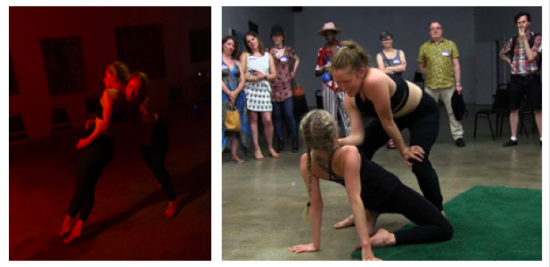
HILOBROW: You two do some of the most linguistic dancing I’ve ever seen — it doesn’t feel like a break in the story but like bridges through it. Dramas of avoidance and reconciliation, struggle and resolution, are moved forward just in the body language. I’ve heard it said dance was probably the first artform, and it’s easy to imagine that gesture preceded speech. Is the line between our bodies and minds, our movements and thoughts an illusory one?
SWISHER: Part of what we are exploring in Crushing Baby Animals is that the lines between everything are illusory. Whether that’s the line between you and your surroundings, your thoughts and the collective unconscious, the past and the present. As humans we divvy things up into categories that are sometimes helpful but are always contextual.
And yes, one of the most pervasive of these is the idea that our minds are us, piloting around our bodies like a small alien operating a big machine. It seems like there are ways of knowing that are hard to access from the thinking brain, and ways that the thinking brain can tie itself up in knots without access to a more embodied perspective. Movement is a powerful tool to understand our existence. Which is one reason we don’t like the audience to sit and consume the entire show from their seats. The play is a journey that moves the body through space and through ideas woven together.
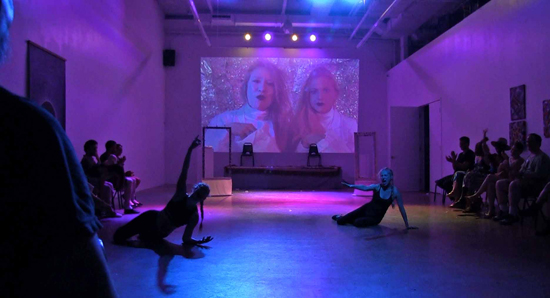
HILOBROW: That might relate to perceived breaches between decision and action. Theoretical physicists will tell us that “the universe has already decided” everything we’re going to do, that we’re playing out a script along the only timeline we can exist in. Does this matter, if the tapestry is too immense to make out, and gives us room to follow as many of our own unique threads through it as we ever could in a lifetime?
SIROIS: “Following the unique threads,” as you put it, seems to be a very important part of the conscious human experience. (In fact, “making the ‘right’ choice” is a huge theme in our play.) Even after Tana and Maria have made it to point B, and seem to have a better understanding of their place in the universe, they still experience attachment to concepts and to their individual identities. It’s very hard not to! Tana and Maria do eventually experience the euphoria and joy in giving yourself over to life — to fully investing, experiencing, and yes, feeling; while also developing an ability to step back from it all and by holding on (loosely) to this idea that perhaps our choices don’t hold quite as much weight as we thought. We call it play.
HILOBROW: Free will, the ability to affect the course of our existences, relates to a preoccupation with underlying mechanisms, sometimes at the expense of appreciating the beauty of complete systems. The characters in Crushing Baby Animals share this obsession, getting in the way of the writing of their own story. But as their creators you seem to have figured out how to be enacting and observing, creating and critiquing at the same time. Might you have any tips for the rest of us? :-)
SWISHER: Tips? Haha. As Tana and Maria’s Doppelgangers point out, “Only a really fucked-up individual would create a play with the goal of teaching themselves and the audience how to live an enlightened life in less than two hours.” Which I suppose is our way of saying, these things are all worth thinking about, but also feeling and moving through physically, without too much attachment. It’s important to take time to be more aware, more compassionate, more connected to our place in what you call the beauty of complete systems. It’s what astronaut Edgar Mitchell described when returning from his trip to the moon as a sense of “the ecstasy of unity.”
Tana and Maria go through a process, beginning by feeling trapped in their traumas, the things that have happened to them and the place they are, overwhelmed negatively by their place in a huge universe. Then they have an unexplained dream that makes them wonder if there is more going on that what appears on the surface, metaphorically, meeting their Whitecoat selves. Through this process of trying to figure out who and what is really in control they allow themselves to oscillate back and forth between realizing the power of their own beings, and realizing that ultimately they are but twigs on the mighty steam of some larger giant beautiful but ultimately deterministic universe. Maybe all they can change is their attitude towards that, not letting the knowledge “make them flabby” … as a mysterious hamster in the show later points out.
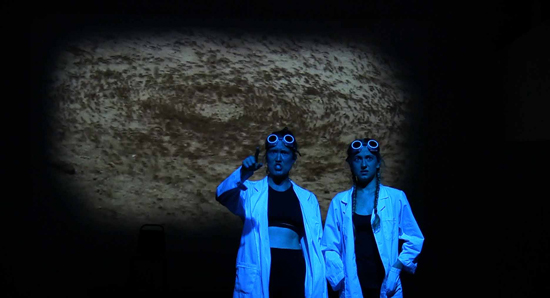
After one performance of CBA we spoke to a young man who said he wasn’t sure if he got it. So we asked him to tell us what he took from the show: “So Tana and Maria want to make a play, but it’s really hard. Then they meet the Whitecoats, who are versions of them, but ones that don’t care about the little stuff so much. And we all have Whitecoats. Is that right?” I think that kid hit the nail on the head. We can afford to allow ourselves the experience of being humans, in the thick of the battle with feelings and emotions, and pains and sufferings, and also be able to have versions of ourselves that can step outside and see a larger picture. Both of these ways of knowing are crucial.

HILOBROW: The elusiveness of objectivity is felt especially intensely in the scenes about “Tana” and “Maria”’s conflicts of aesthetics and personality. The fights feel so immediate and impassioned, though they must be meticulously composed — and reconstructed from moments in our lives that are among the least thought-out, and thus must be the hardest to analyze afterward. How do you access such intense emotional recall while keeping removed from it?
SIROIS: Well, it’s no secret that the “real world Tana and Maria” scenes are built from our own experience as artists making work together. I would say, anything “meticulous” that happens in the scenes, is a result of us as individual actors making sure we know exactly what we want, and how we feel about anything that might come up in the improvisation so we can respond with as much truth as possible. The argument scenes are actually the scenes that change the most from each performance to the next, because although they are “structured” improv, we try to let the scenes drive themselves, taking us through different versions of conflict each night. These conflict scenes aim to explore what it’s like to simultaneously feel the need to protect ourselves, ask for what we want, and ultimately experience connectivity in each other.
HILOBROW: Certain wishes and ambitions must remain eternally unreachable or else it’s not an Inferno — the way that the grand statement the characters want to make stays just out of their grasp is a clever cosmic joke about the existential mourning of their literary model. And yet Crushing Baby Animals is “about” so much more than just its circular self — childhood personal trauma, adult civic helplessness, recurrent self-doubts, contemplation overload. Is the secret to be still, at the center, and truly see the truths swirling around us, rather than fixating on “getting somewhere”?
SIROIS: Getting somewhere can definitely be a trap, but staying still at the center of it all doesn’t sound like a very rich life experience, either. I think it’s about finding a balance. The journey to “get somewhere” can be great fun and result in beautiful growth, but if we cling to our ideal outcome and deliberate over our choices too much, we miss the joy and calm in embracing our lack of control. I mean, I think we should definitely vote. And recycle. And absolutely allow ourselves to care deeply about the things we care deeply about. But yes, there is a power in learning to be still, at the center of it all when that is what you need.
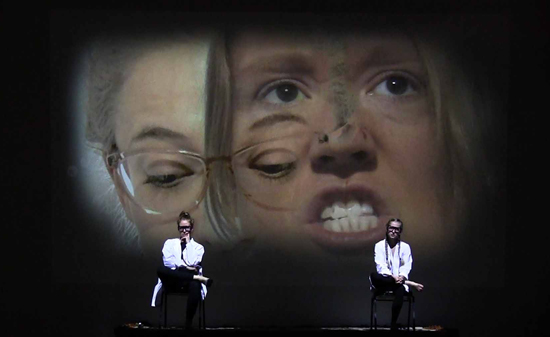
SWISHER: Knowing that we are “waterfalls and not rocks” as the Whitecoats point out, means acknowledging process as part of existence, that I am not now what I was one minute ago. Letting go of expectation, and living in a sort of beautiful discomfort and danger that allows for newness and transformation, whether that is through stillness or suffering or chaos. There is space for all of that, and a need for Inferno to come to moments of Paradiso.
“At the still point of the turning world. Neither flesh nor fleshless;
Neither from nor towards; at the still point, there the dance is,
But neither arrest nor movement. And do not call it fixity,
Where past and future are gathered. Neither movement from nor towards,
Neither ascent nor decline. Except for the point, the still point,
There would be no dance, and there is only the dance.” — T.S. Eliot
HILOBROW: Circus and spectacle seem to be built-in human needs, from tribal ritual to traveling pantomime to The Avengers. And you stir in much of it: silent-movie slapstick, Marx Brothers-ist mad scholarship, corporate team-building, sci-fi farce, downhome singalong, Broadway kitsch, and obligatory 1960s-movie acid-trip scenes. Are these and other elements things you feel are just fun to include because of their incongruousness, or things you feel are equally legitimate and worth incorporating?
SWISHER: A lot of what we do with our work and have pushed to the brink with Crushing Baby Animals is the stylistic disintegrity. It’s along the lines of what Augusto Boal talks about in his work with political theatre for the masses, as well as what Peter Brook is talking about in The Empty Space when he refers to “Holy Theatre.” It’s also, by the way, what Mary Poppins talks about when she says “a spoonful of sugar helps the medicine go down.”
Genre shifting is super Boalian, and something we’ve been attracted to for a long time. It’s an attempt to meet people where they are, to be utterly specific in the way we address audiences, using their languages. It is the feeling of recognizing something very familiar, something pop-culture, or that allows us to twist it very slightly, and reintroduce for critical distance. CBA is fast, it uses montage, it is a collage of incongruous elements, and it attempts to touch people on a primal, visceral, emotional level, without getting stuck in that area too long. It’s also a show created for audiences experiencing the world digitally, in redigested chunks. This is a way of not only exploring the everythingness of a multiverse lorded over by two Joker-like characters, but a way of allowing us to dis-integrate, to break things down, to push them to their limit and then, just when the audience nears fatigue, to look at them from an opposite angle.
Giving ourselves the freedom to ask, “what is the best language to discuss what we want to discuss,” regardless of whether we break rules, ultimately leads to a very Circus-like feel. It is thought out with a lot of specificity, given a container, so to speak, and then allowed to be as dirty as possible. That’s the idea anyway.
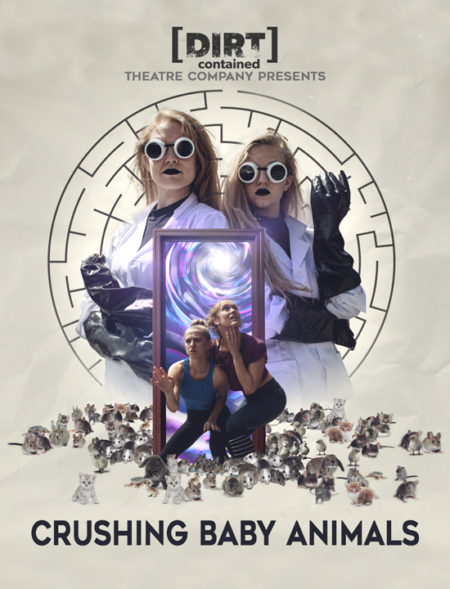
HILOBROW: Did you at any point write dialogue or storylines for each other’s character?
SIROIS: We definitely wrote dialogue for each other (specifically some of the more direct descriptions of each other’s pasts… there is a type of truth achieved when writing about someone else that’s difficult to find when you’re writing about yourself). Honestly, I think we wrote the majority of the show without a huge thought as to which character was saying which line. It’s not uncommon for us to trade lines in the performance depending on which one of us feels compelled to jump in. It’s challenging to even remember whose line is whose, sometimes! I always like when that happens though (even if it throws a bit of momentary panic into the scene for us as actors), because it shows that although Tana and Maria (or Whitecoat Tana and Whitecoat Maria) often seem to be in perpetual conflict, they are also so often on the same page, wanting the same thing.
(Crushing Baby Animals next collapses into a black box at Greenwich Village’s pioneering IRT Theatre, August 6-9, 2019; keys to the universe here)
Photos (top to bottom) by George McClintock (1, 2, 6) and William Hopkins (3, 4, 5, 7); poster image by Katelyn Kopenhaver (photos) and Marco Baratto (design)
MORE POSTS by ADAM McGOVERN: OFF-TOPIC (2019–2025 monthly) | textshow (2018 quarterly) | PANEL ZERO (comics-related Q&As, 2018 monthly) | THIS: (2016–2017 weekly) | PEOPLE YOU MEET IN HELL, a 5-part series about characters in McGovern’s and Paolo Leandri’s comic Nightworld | Two IDORU JONES comics by McGovern and Paolo Leandri | BOWIEOLOGY: Celebrating 50 years of Bowie | ODD ABSURDUM: How Felix invented the 21st century self | CROM YOUR ENTHUSIASM: C.L. Moore’s JIREL OF JOIRY stories | KERN YOUR ENTHUSIASM: Data 70 | HERC YOUR ENTHUSIASM: “Freedom” | KIRK YOUR ENTHUSIASM: Captain Camelot | KIRB YOUR ENTHUSIASM: Full Fathom Five | A 5-part series on Jack Kirby’s Fourth World mythos | Reviews of Annie Nocenti’s comics Katana, Catwoman, Klarion, and Green Arrow | The curated series FANCHILD | To see all of Adam’s posts, including HiLo Hero items on Lilli Carré, Judy Garland, Wally Wood, and others: CLICK HERE
